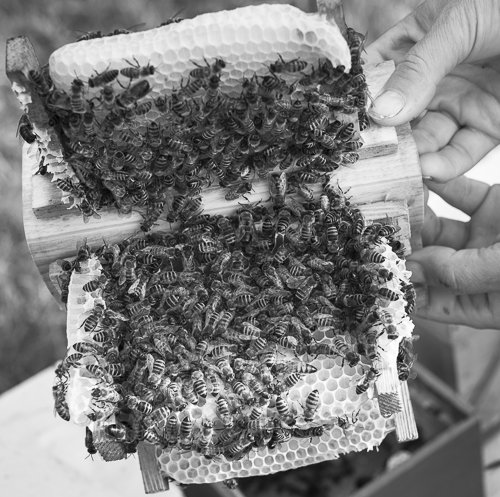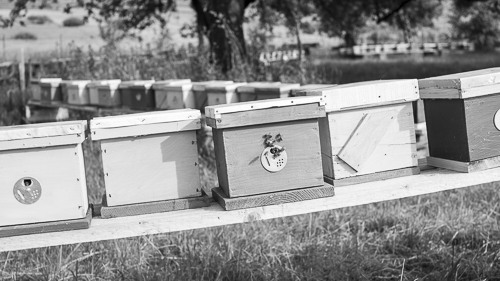We met Melinda Szász at her family’s house from which she and her husband llyés are making a living from organic beekeeping only. We were invited into their living room where Mr. Szász had made an exquisite bookcase to exhibit their products, ranging from various types of honey where the beehives had been freighted near specific types of plants, creamed honey, honeycomb, propolis, pollen and beeswax figures .
We got a taste of the following honeys:
- Acacia or wattle honey from wattle trees near the Danube.
- Meadow honey from wildflower meadows near Corund .
- Forest honey from honeydew, the sweet secretions of aphids.
- Linden honey from linden or lime trees.
Each of them had their specific colours, tastes and consistencies and all of them were good.
Ms. Szász learnt about beekeeping from her mother, who was a zoo-technology engineer, she read about beekeeping and helped her father with beekeeping while she was young, but she didn’t see the beauty of it. Later, she studied at a university under distinguished professors from Cluj-Napoca and Budapest and she made a thesis on beekeeping when she finally saw the beauty of it. Her husband was already doing beekeeping when they met and the Szász family have been doing beekeeping for 20 years, while they have made a living from organic beekeeping for the last 4 years. Their company has 5 full-time employees and 2 part-time workers who work from May to August.
After having got an introduction to their company and tasted some of their products, we followed Ms. Szász into the garden where there were lots of beehives, 150 in all, some for producing honey and a long row of tiny ones for breeding, The tiny beehives looked like small boxes inside of which were 3-4 frames where one queen bee and a lot of worker bees were living. The queen bee would fly out of the beehive and mate 7-15 times with drones in the air, gather seed for 3 days, then she would re-enter the hive and stay there for the rest of her life. We were also shown a wax queen cup, in which a newly mated queen bee was staying. The beekeepers kept her there in order to estimate the quality and health of her eggs.
This company also tries to produce 100-150 queen bees per year and replace the whole population after 4-5 years. Of course, they have to take precautions to avoid in-breeding and breeding with drones from other beekeepers’ beehives. The last one is obtained by ascertaining that other drones are a minimum distance away from where the mating takes place.
In addition to these beehives, they have 3 more sets of beehives in other places in Romania and all of the bees are Carpathian honey bees, apis melifera carnica.
Beekeepers also have to protect their bees against a parasite called Varroa destructor and the only chemical they are allowed to use to fight it is oxalic acid in order to keep their certificate for doing organic beekeeping.
They are selling products derived from bees like:
- Acacia honey with juniper berries
- Raspberry honey
- Coriander honey
- Honey with propolis
- Honey with walnuts
- Creamed honey with blueberries
- Creamed honey with blackcurrant
- Creamed honey with sea buckthorn fruit
- Propolis tincture
In addition, they are also selling various tools for beekeeping like bee smokers to calm the bees, marker pens for marking queen bees, plastic cages for housing queen bees, protective clothing, beehives, which are made by Mr. Szász from Norway spruce in a workshop next to their house, frames, uncapping forks, extractors for extracting honey, etc. In short, they are selling everything, which beekeepers need.
It was a great pleasure visiting someone who obviously does so much for beekeeping as Ms. Szász.
For those who want to know more about bees and how to help them, please have a look at The Ultimate Guide to British Bees: How to Protect Their Declining Population and Protecting Britain’s bees – How to look after them and prevent their decline.


